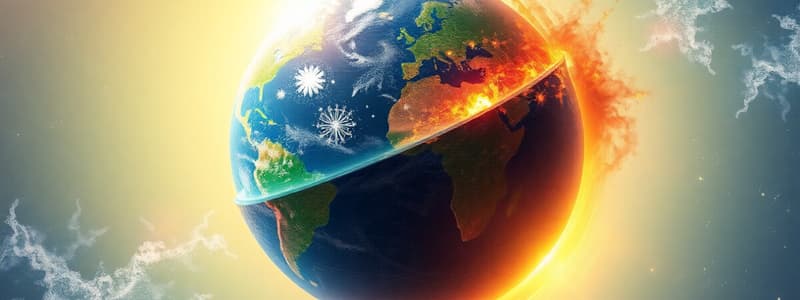Podcast
Questions and Answers
What primary factor, combined with Earth's revolution around the Sun, leads to the occurrence of distinct seasons?
What primary factor, combined with Earth's revolution around the Sun, leads to the occurrence of distinct seasons?
- The elliptical shape of Earth's orbit.
- The Earth's axial tilt of 23.5 degrees. (correct)
- Variations in the Earth's rotational speed.
- Changes in the Sun's energy output during the year.
During which season does the hemisphere tilted away from the sun experience?
During which season does the hemisphere tilted away from the sun experience?
- Winter, characterized by shorter days. (correct)
- Fall, characterized by decreasing temperatures.
- Spring, characterized by moderate temperatures.
- Summer, characterized by longer days.
What occurs during the equinoxes (spring and fall) concerning sunlight distribution on Earth?
What occurs during the equinoxes (spring and fall) concerning sunlight distribution on Earth?
- The Northern Hemisphere receives maximum sunlight, while the Southern Hemisphere receives minimal sunlight.
- One hemisphere receives significantly more sunlight than the other.
- The Southern Hemisphere receives maximum sunlight, while the Northern Hemisphere receives minimal sunlight.
- Both hemispheres receive approximately equal amounts of sunlight. (correct)
Why does the Earth experience two high tides per day?
Why does the Earth experience two high tides per day?
What is the relative position of the Sun, Moon, and Earth during spring tides, and what effect does this alignment have on the tides?
What is the relative position of the Sun, Moon, and Earth during spring tides, and what effect does this alignment have on the tides?
What is the alignment of the Sun and Moon during neap tides, and how does this alignment affect high and low tides?
What is the alignment of the Sun and Moon during neap tides, and how does this alignment affect high and low tides?
If the Earth's axial tilt were decreased to 10 degrees, what would be the most likely effect on the seasons?
If the Earth's axial tilt were decreased to 10 degrees, what would be the most likely effect on the seasons?
The gravitational pull of the moon has the greatest influence on tides. Approximately how much more influence does the moon have compared to the sun?
The gravitational pull of the moon has the greatest influence on tides. Approximately how much more influence does the moon have compared to the sun?
Imagine a coastal region that typically experiences a spring tide range of 10 feet. What tidal range might be expected during a neap tide in the same location?
Imagine a coastal region that typically experiences a spring tide range of 10 feet. What tidal range might be expected during a neap tide in the same location?
If the Earth's rate of rotation significantly slowed down, what would be the most likely effect on the frequency and duration of high and low tides?
If the Earth's rate of rotation significantly slowed down, what would be the most likely effect on the frequency and duration of high and low tides?
How would seasons be affected if Earth's orbit were perfectly circular instead of elliptical?
How would seasons be affected if Earth's orbit were perfectly circular instead of elliptical?
During a full moon, what type of tide is most likely to occur?
During a full moon, what type of tide is most likely to occur?
If you are experiencing high tide, approximately how many hours until you experience low tide?
If you are experiencing high tide, approximately how many hours until you experience low tide?
When the Northern Hemisphere experiences Summer, which of the following is also true?
When the Northern Hemisphere experiences Summer, which of the following is also true?
If the moon were significantly closer to Earth, what would be the most immediate and noticeable effect?
If the moon were significantly closer to Earth, what would be the most immediate and noticeable effect?
What is the primary cause of spring tides?
What is the primary cause of spring tides?
In what phase is the moon during neap tides?
In what phase is the moon during neap tides?
Which of the following statements explains why coastal regions experience two high tides and two low tides each day?
Which of the following statements explains why coastal regions experience two high tides and two low tides each day?
Why are tides important for coastal ecosystems?
Why are tides important for coastal ecosystems?
Considering the relationship between the Earth's tilt and the seasons, what would occur if the Earth had no tilt?
Considering the relationship between the Earth's tilt and the seasons, what would occur if the Earth had no tilt?
Flashcards
Earth's Tilt
Earth's Tilt
Earth is tilted at approximately 23.5 degrees relative to its orbit around the Sun.
Constant Tilt Direction
Constant Tilt Direction
As Earth orbits the Sun, its tilt remains oriented towards the North Star.
Uneven Sunlight Distribution
Uneven Sunlight Distribution
Different parts of Earth receive varying sunlight due to the tilt.
Summer (Tilt Towards Sun)
Summer (Tilt Towards Sun)
Signup and view all the flashcards
Winter (Tilt Away From Sun)
Winter (Tilt Away From Sun)
Signup and view all the flashcards
Spring and Fall (Equinoxes)
Spring and Fall (Equinoxes)
Signup and view all the flashcards
Lunar Gravitational Pull
Lunar Gravitational Pull
Signup and view all the flashcards
High Tide (Moon Side)
High Tide (Moon Side)
Signup and view all the flashcards
High Tide (Opposite Side)
High Tide (Opposite Side)
Signup and view all the flashcards
Low Tides
Low Tides
Signup and view all the flashcards
Spring Tides (Alignment)
Spring Tides (Alignment)
Signup and view all the flashcards
Neap Tides (Right Angles)
Neap Tides (Right Angles)
Signup and view all the flashcards
Spring Tide Characteristics
Spring Tide Characteristics
Signup and view all the flashcards
Neap Tide Characteristics
Neap Tide Characteristics
Signup and view all the flashcards
Study Notes
- The Earth's tilt and its revolution around the Sun cause seasons
- The Moon and Sun's gravitational pull influences tides
Earth's Tilt and Seasons
- The Earth is tilted at approximately 23.5 degrees relative to its orbit around the Sun
- The Earth's tilt remains pointed in the same direction towards the North Star as it revolves around the Sun
- It takes the Earth approximately 365.25 days to revolve around the sun
- Different parts of Earth receive varying amounts of sunlight throughout the year due to the tilt
How Earth's Tilt Causes Seasons
- Summer occurs in the hemisphere tilted towards the Sun, experiencing more direct sunlight and longer days
- Winter occurs in the hemisphere tilted away from the Sun, experiencing less direct sunlight and shorter days.
- During the spring and fall equinoxes, both hemispheres receive approximately equal sunlight, resulting in moderate temperatures
- The Northern Hemisphere experiences summer when tilted toward the Sun, while the Southern Hemisphere experiences winter, and vice versa
Moon, Sun, and Tides
- Tides are mainly caused by the gravitational pull of the Moon and to a lesser extent, the Sun
How the Moon's Gravity Affects Tides
- The Moon's gravity pulls on Earth's oceans, creating a bulge (high tide) on the side of Earth facing the Moon
- A second high tide occurs on the opposite side of Earth due to the inertia of the water
- Low tides occur in areas perpendicular to the high tides
Spring and Neap Tides
- Spring tides occur when the Sun, Moon, and Earth align (during a new moon or full moon)
- The gravitational forces of the Sun and Moon combine during spring tides, creating higher high tides and lower low tides
- Neap tides occur when the Sun and Moon are at right angles (during a first or third quarter moon)
- The forces of the Sun and Moon partially cancel each other during neap tides, resulting in lower high tides and higher low tides
Studying That Suits You
Use AI to generate personalized quizzes and flashcards to suit your learning preferences.




